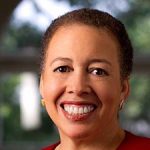Wesleyan Community Reacts to George Floyd’s Death

After George Floyd, a 46-year-old black man, was killed during his arrest on May 25 in Minneapolis, sparking nationwide demonstrations, members of Wesleyan’s administration and alumni are speaking out against racial injustice and offering resources for community members.
On May 30, Wesleyan President Michael Roth ’78 shared a Roth on Wesleyan post titled “Build an Anti-Racist Community in Which Hatred and Intolerance Have No Place.”
Ahmaud Arbery, Breonna Taylor, George Floyd. We speak their names with sorrow and with anger. In recent weeks, we confront once again the fact that in America some people so radically devalue African Americans that their lives can be just brutally destroyed. The precarity of black lives has a very long history in this country, but now technology makes it possible for people everywhere to witness violent injustice. We witness, and we are disgusted; we witness, and we are enraged; we witness, and we mourn. Black Lives Matter.
As a historically white institution, Wesleyan has struggled with our own history of racism. Over the last several decades, thanks to the work of activist students, faculty, staff and alumni, we have become more aware of the ways in which the ideology of white supremacy has affected this history and our own present. We try to build a different kind of community – one in which racism, hate and intolerance have no place. This is an ongoing project, and we re-dedicate ourselves to it.
Our Wesleyan education includes the aspiration to act “for the good of the world.” Rejecting hatred and the violence it inspires, we can engage with others to construct alternatives to poverty, marginalization and prejudice. We witness and we choose how to respond; let us do so in ways that prefigure the kind of world we hope to build.
The message was signed by Wesleyan Cabinet members David Baird, vice president for information technology; Amin Abdul-Malik Gonzalez, vice president and dean of admissions; Anne Martin, chief investment officer; Sean McCann, chair of the faculty; Nicole Stanton, provost and senior vice president for academic affairs; Andrew Tanaka, treasurer and senior vice president; Michael Whaley, vice president for student affairs; Alison Williams, vice president for equity and inclusion; Frantz Williams, Jr., vice president for advancement; David Winakor, general counsel and secretary of the University; and Renell Wynn, vice president for communications.
Campus and Educational Resources

On June 1, Alison Williams ’81, vice president for equity and inclusion/Title IX officer, shared a list of resources on Wesleyan’s Community Forum:
As we have been forced to face the legacy of racism and marginalization that plagues our country in so many ways, people have approached me to ask ‘What Can I Do?’ Below are some links to resources that I hope you will find to be useful. In addition, we will schedule time for the Wesleyan community to gather via Zoom, to discuss these events, and determine how we should move forward together. Please stay tuned for forthcoming details.
If you are not familiar with the deep history and legacy of violence against the Black community in the United States, and how this has a powerful impact on the lives of all Black Americans, here are some suggested readings.
For history: Ibrahim X. Kendi’s Stamped from the Beginning or Jill Nelson’s Police Brutality: An Anthology are good places to start.
Policy proposals to reform policing, see Campaign Zero.
Evie Shockley’s “can’t unsee.”
Running For Your Life: A Community Poem for Ahmaud Arbery
Podcasts
This episode of Code Switch,
Ezra Klein podcast on health disparities by race.
Seeing White series.
Other Resources:
75 Things White People Can Do for Racial Justice
Anti-racism resources for white people
Resources for White People to Learn and Talk About Race and Racism
If you have the means, lend support to those who are struggling. This can take the form of simple outreach and emotional support (“I am here for you”). It can involve volunteering for efforts to reform the justice system and make it more equitable. It can mean contributing to efforts to support protests or support communities that have been impacted by the protests.
With your help, I would like to facilitate two reading groups this summer. The two award-winning books we will read together are:
“How to Be an Anti-Racist” by Ibram X. Kendi and “White Fragility: Why It’s So Hard for White People to Talk About Racism” by Robin DiAngelo and Michael Eric Dyson. My hope is that these readings will initiate a conversation that will continue when we are together again, and moves us beyond talk to meaningful action. I encourage you to order these books from Wesleyan RJ Julia or your local bookstore, or check them out from a library.
Know that as a community who values the liberal arts traditions, we can educate ourselves about the matters at hand, raise our voices to challenge hatred and bigotry, and work together to find concrete ways to move forward.
…
Many of you have asked for resources to help your children process what is happening in our country. Here are some resources that have been recommended for school age children and youth:
https://www.embracerace.org/resources
These two articles offer useful advice on how to talk to children about anti-Black racism, police violence, and the uprisings:
George Floyd. Ahmaud Arbery. Breonna Taylor. What do we tell our children? with advice from acclaimed Black psychologist Dr. Beverly Tatum
How do I make sure I’m not raising the next Amy Cooper? – an article by White author Jennifer Harvey on raising white children for racial justice.
Book suggestions:
For preschool and elementary school-aged kids
“Something Happened in Our Town” by Marianne Celano, Marietta Collins and Ann Hazzard.
Best-selling stories to help younger kids:
“The Colors of Us” by Karen Katz
“Let’s Talk About Race” by Julius Lester
“The Skin I’m In: A First Look at Racism” by Pat Thomas
Sesame Street’s “We’re Different, We’re the Same” by Bobbi Jane Kates
“Something Happened in Our Town: A Child’s Story about Racial Injustice” by Marianne Celano, Marietta Collins, and Ann Hazzard
“I Am Enough” by Grace Byers
“Happy in Our Skin” by Fran Manushkin and Lauren Tobia
“Voice of Freedom: Fannie Lou Hamer: The Spirit of the Civil Rights Movement” by Carole Boston Weatherford and Ekua Holmes
“Raising White Kids: Bringing Up Children in a Racially Unjust America” by Jennifer Harvey
“Daddy Why Am I Brown?: A healthy conversation about skin color and family” by Bedford F. Palmer
“A Terrible Thing Happened” by Margaret Holmes
“Antiracist Baby” by Ibram X. Kendi
For teens:
“The Hate U Give” by Angie Thomas
“Harbor Me” by Jacqueline Woodson
“This Book Is Anti-Racist: 20 Lessons on How to Wake Up, Take Action, and Do The Work” by Tiffany Jewell and Aurelia Durand
“Brown Girl Dreaming” by Jacqueline Woodson
“Dear White People” by Justin Simien
Books by our honorary degree recipient and award winning author, Jacqueline Woodson, including The Other Side and Show Way
https://www.jacquelinewoodson.com/category/books-ive-written/
‘First look for sameness’ by Kristen Bell is new children’s book that urges kids & adults to focus on commonality.
16 Books About Race That Every White Person Should Read
Local Community Organizations
Middlesex County NAACP
Middletown Racial Justice Coalition
Ministerial Health Alliance, and
George W. Crawford Lodge
Mayor Florsheim ’14 on Peaceful Middletown Protest

In a May 31 Facebook post, City of Middletown Mayor Ben Florsheim ’14 described and shared photos of a peaceful protest in downtown Middletown on May 30 that included members of the Wesleyan community:
Last night, hundreds of people (750, according to press reports) gathered peacefully in downtown Middletown to mourn the death of George Floyd, to condemn his murder at the hands of the Minneapolis Police, and to demand justice for him and the inexcusably growing list of other black people who have been killed by police violence and white supremacy.
I am grateful to everyone who was a part of this important event. Thank you for your presence.
…
After the megaphone was put away, the rally turned into more of a dialogue. Several smaller groups emerged with people going back and forth, some more heatedly than others. I am deeply grateful for many of the comments and questions that were expressed by Middletown residents. During a conversation with several protesters, I was able to answer some questions about what local government is already doing with regard to racial justice and policing. I was also able to hear from them a desire, an insistence, that we need to be doing more.
So let me address these three central questions:
What are we doing now to prevent the killing of black people in our community? What more will we do in the future to prevent such violence? How can the public be more involved?
The answer to the first question is both “a lot” and “not enough.” Clearly, there needs to be more transparency and communication about the work that both the city and MPD are doing to advance racial justice and to improve police-community relations. And the list of things we are working on needs to grow, along with the number of people who are involved in doing that work. But it is a question I want to answer with some facts about what’s already going on:
In 2017, the city began funding a partnership the Human Relations Commission (a city board, whose members are appointed by the mayor), the Middletown Racial Justice Coalition, and an outside organization called the National Conference for Community and Justice to undertake a comprehensive anti-racism project. Part of that project has been requiring racial justice training for every city employee, including every member of the police department, a process that is ongoing to this day.
In my budget, I proposed renewing funding for the project to continue into 2021, and at the Common Council budget workshop that took place this past Wednesday, it was met with enthusiastic support not just from council members but from city directors who have been involved with the project through those racial justice trainings.
The Middletown Police Department has extremely high training and vetting standards; as Chief McKenna has explained to me, “we take the candidates who we think are basically qualified, and then we look for any reason at all not to hire them.” A record of complaints at a previous police agency is a disqualifier. … The department has actively partaken in the racial justice trainings and significantly ramped up its outreach efforts to find and hire more officers of color. All this needs to be more widely known and transparently presented, and I will work with the MPD in the coming days to make the details of these efforts accessible to all.
…
The more salient questions are #2 and #3: what happens next? And how can the public be involved?
The answers are related because our ability to do what needs to be done is contingent on more people being a part of it. From a policy standpoint, I think there are a few things we should clearly look at. One is making sure that– as in Minneapolis– the act of not intervening when an officer witnesses police brutality is also a fireable offense in addition to the act of brutality itself. Another is establishing some form of community oversight for MPD to ensure that complaints and concerns are addressed and reviewed externally as well as internally. Yet another is to increase the scope of the citywide anti-racism partnership, strengthen its community outreach efforts, and continue it in perpetuity as an ongoing practice of city government, rather than simply funding it through next year.
As to how to get involved, that’s both the easiest and hardest one to answer. While my staff and I strive to make government transparent and accessible, one problem is that not everyone has the time or ability to access the information necessary for becoming more involved in local politics. That means city government needs to come to the people, not just wait for the people to come to us. The need for that was, in fact, one of the main reasons I ran for mayor; with the help of the community, it is something I hope to help change about the political culture in Middletown. In the first couple of months of my term, I held regular in-person town hall meetings in different locations and began meeting with all of the city’s citizen boards and commissions in the hope of broadening their work to more people and more issues. The COVID-19 pandemic changed much of that, with everything moving online and the city’s day-to-day focus becoming consumed with crisis response. As soon as it is safe, those public meetings will resume. If there are topics you think we need to be having community meetings about, or particular groups of people who need to be involved, let me know in the comments and we can start to plan…
…
I’ve used a lot of words to say that words are not enough, but I do need to say one final thing. There is a difference between being personally “not racist” and being actively engaged in anti-racism. White people like myself have an obligation in this moment to forget about the first thing and focus on the second thing. We need to take our own feelings out of the equation and begin to intentionally and explicitly fight against racism in all its forms. The only absolution to be found will not be given to us; we must create it ourselves through our actions. We must use our voices now not to demonstrate to people of color that we are on their side, but to demonstrate to other white people why racial justice matters to us and why it should matter to them too.
The work is beginning. Let us ensure it is completed. #BlackLivesMatter
Tatum ’75: “What do we tell our children?”

In a May 31 USA Today article titled “George Floyd. Ahmaud Arbery. Breonna Taylor. What do we tell our children?” Beverly Daniel Tatum ’75, Hon. ’15, P’04, shared her views on talking to children about racial violence. Tatum is a psychologist and author of Why Are All The Black Kids Sitting Together in the Cafeteria? And Other Conversations About Race. (Read more in this Wesleyan University Magazine article.)
“Silence will not protect you or them,” Tatum said in the article. “Avoiding the topic is not a solution.”
Read the full article on USA Today. An excerpted portion of the article follows:
Why is it important to talk with children about what happened to George Floyd and other incidents of police brutality or racism in the news?
Beverly Daniel Tatum: Even young children may see or hear about highly publicized incidents like the George Floyd case – perhaps overhearing the TV or the radio – and may ask questions. Or if parents are upset by the news, the child may perceive the parent’s distress and ask why mom or dad is upset. In either case, an age-appropriate explanation is better than silence. Older children with Internet access may see online images on their own. Initiating an age-appropriate conversation can give children a helpful frame for understanding difficult realities. If parents are silent, children will draw their own often faulty conclusions about what is happening and why.
How can parents talk about law enforcement in a way that is honest but also doesn’t discourage children from seeking help from law enforcement when appropriate?
BDT: Most police officers become police officers because they want to help people. And there are times when we would really want a police officer to help us – give some examples – if there’s been a car accident, or if someone took something that belonged to us, etc. But sometimes a police officer does something bad, like today. When that happens, we might start to think that all police officers are like that. But it’s important to remember that that is not true.

